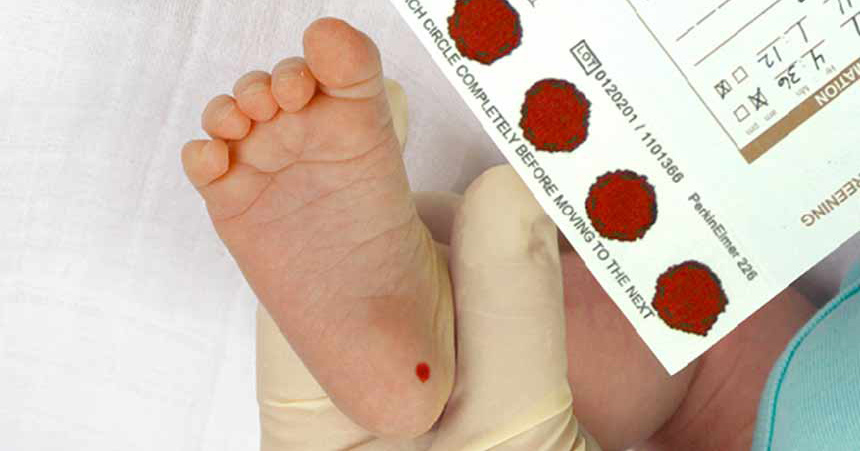Advocacy is in our blood. Jessica spent more than a decade of her career in public service and the desire to get things done is part of the DNA of our family. While our primary focus is on Clara’s diagnosis and treatment, the thought remains present in our minds and hearts that whatever needs to be done to help others avoid this cruel and heartbreaking situation should be done, and we want to help.
Numerous effective, established organizations do outstanding work advancing the detection and scientific understanding of the ever-increasing number of known and unknown Leukodystrophies. Others work with families and provide support and resources in times of great need. Some do both…and then some.
Our goal is to connect with, and learn from all of them and take pages from their play books as we find ways that we can help advance the ability to detect and treat these rare diseases as early as possible, and help the families and individuals that are affected by them.

NEWBORN SCREENING (NBS)
Often, Leukodystrophies are detected when an older sibling becomes symptomatic and then younger children are tested. In the case of some Leukodystrophies (MetachromaticLeukodystrophy, Adreno Leukodystrophyor Krabbe Leukodystrophy) hematopoietic stem cell transplant, bone marrow transplant or experimental gene therapy (only currently for Metachromatic Leukodystrophy) can often be effective in halting disease progression before symptoms begin for the asymptomatic younger kids, but by then it’s often too late to save the older child whose disease has silently and invisibly progressed to the point that symptoms are apparent.

This unimaginable scenario has played out over and over and over again and is simply devastating for families. If this situation can be prevented, it should be.
A number of Leukodystrophies and other rare white matter diseases could be detected through newborn screening, allowing disease-altering measures to be taken immediately.
Currently, very few states include Leukodystrophies in their newborn screenings for various reasons. We are beginning to explore how we can work with California legislators to help establish our state as the nationwide leader in the core public health responsibility of advancing Newborn Screening.
We intend to carry the mantle that so many others have been working on over the years to make it easier for testing to be conducted and for these diseases to be added to more newborn screening tests. We have been in close contact with the MLD Foundation about these efforts, as they have been on the forefront of advancing Newborn Screening (NBS) for Leukodystrophies and other rare diseases for years through numerous efforts including the RUSP Roundtable.
Working in collaboration with others organizations, they have had numerous successes in California and elsewhere. The MLD Foundation is also very active in federal and state policy in support of NBS, as well as improving research and clinical care for rare diseases, which includes all of the Leukodystrophies.
SCIENTIFIC RESEARCH AND AWARENESS
 The Global Leukodystrophy Initiative, the Myelin Project, the United Leukodystrophy Foundation, and others advocate for research and awareness about Leukodystrophies on a national and international scale and assisting families with education and assistance about these very complex and rare diseases. Organizations such as the Calliope Joy Foundation are active at the grass roots level, providing support and assistance to families experiencing the difficulties of the process of diagnosis, travel and treatment.
The Global Leukodystrophy Initiative, the Myelin Project, the United Leukodystrophy Foundation, and others advocate for research and awareness about Leukodystrophies on a national and international scale and assisting families with education and assistance about these very complex and rare diseases. Organizations such as the Calliope Joy Foundation are active at the grass roots level, providing support and assistance to families experiencing the difficulties of the process of diagnosis, travel and treatment.
New Leukodystrophies are discovered each year, and the science of disease identification is advancing within genome sequencing. It is important to track the progression of known and unknown Leukodystrophies, once identified, so that in years to come, those with the same diagnosis will have a clearer understanding of how the disease is, or is not, likely to progress, and so that treatment through stem cell transplant, bone marrow transplant or gene therapy, which has been advanced internationally, but is barely in its infancy in the United States, can be developed.
The great unknown is one of the most frightening parts of being affected by any rare disease, and for many families and individuals with various Leukodystrophies, the unknown is unending. Additionally, because the diseases are so rare, affected families can feel very alone in their struggles. Scientific research into Leukodystrophies and increased awareness of all kinds of white matter diseases will help ameliorate that difficulty for families in years to come.
Currently, Clara’s future is unknown, and we hope with every atom of our beings that her disease will not be progressive, or if it is, treatment will become available before she becomes symptomatic. No matter what, we are dedicated to ensuring as few other families as possible have to go though what we are experiencing, now or in the future.

